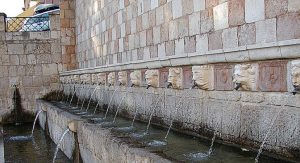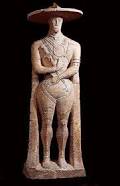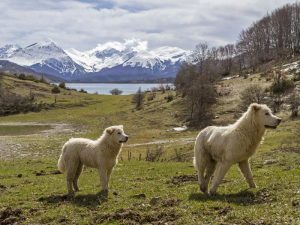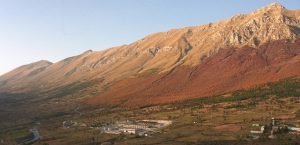|
Abruzzo is the unspoiled heart of the Italian peninsula. This region where the north of
Italy meets the south, is also one of the most beautiful regions of Italy. To the west,
Abruzzo is bordered by the Apennine mountains while to the east the long sandy beaches
of the Adriatic await you. Abruzzo also offers great skiing; around L’Aquila alone there
are 22 ski resorts. You can ski in the morning and go to the beach in the afternoon, perfect!
Large parts of western Abruzzo are national parks and the Parco Nazionale del Gran Sasso
is just one example of the unspoilt, breathtaking scenery of the region. Located in the park
is the Gran Sasso itself, Abruzzo’s highest mountain and from whose summit you are able
to see both the Adriatic sea to the east and the Tyrrhenian sea to the west.
TOWNS
Most of the towns in the Abruzzo region are a bridge between tradition and modern-day
life. History makes its presence felt almost everywhere in the form of old churches,
castes villas and Palazzi. Yet all the conveniences associated with modem living are also
present. Whether you are interested in culture or just want to enioy the shops
and atmosphere. There’s something here for everyone.
The towns do not have the same sprawling dimensions as other regions. The large
number of public squares are used as a meeting place for old and young. especially
during summer months. Maintaining a cultural identity and a low population
density (1.25 million residents in the entire have given the Abnrzzo region ltaly‘s
lowest crime rates. The standard of living is high and foreign tourists are still a
ranty in the towns. Italian is still spoken in the cafés and bars, the Abruzzo region
is still a paradise for ltalian authenticity!
L’AQUlLA
L‘Aquila with its 70,000 residents is situated on the southwest side of the Parco
Nazionale del Gran Sasso at 721m above sea level. The town has been enjoying
economic growth over the last few years. A university town (founded in 1458),
it is a lively and dynamic place with rich cultural life. lt often plays host
lo jazz concerts and theatre performances.
The large number of “Piazze“ which are all adorned with fountains, churches or churches or
Palazzi, the fashion boutiques
and nice restaurants all
conspire to make L‘Aquila
an inviting town with the
charm of the undiscovered.
Here you can enjoy the Italian
way of life in the town‘s
many elegant cafes and cappuccino
bars, in the warm summer
months life in the town moves
out into the streets. You can sense a zest for life and, rooted in its own history,
the town’s identity. The town is characterised by its Romanesque architecture.
The most important church in L‘Aquila is the Basilica by S. Maria di Collemaggio
dating back to 1287. lt‘s typical of the Romanesque style found in the Abruzzo region.
Those interested in art will find small attractions in every corner of the town centre:
Churches and frescos from the Middle Ages, renaissance and baroque periods,
charming courtyards, arcades, “Palazzi Nobiliari” (noble palaces) and manor houses
(Palazzo Centi, Palazzo Dragonetti the renaissance manor house of Jacopo cli Notar
Nanni, the Villa of Buccio di Ranallo, and Palazzo Alfieri among others).
There is a pleasant small pine forest on the outskirts of the town a “green lung“ where
you can go on those hot summer evenings for a breath of cooler air.
CHIETI
Chieti is the ancient Teate which was the main city of the italic Marrucini population.
In Roman times (about the first century B.C.)
Chieti was a Roman municipality. It lies on the hills on the right side of the river
Pescara and from the city you can see as far as the mountains of Gran Sasso and
the Maiella. Its Cathedral is dedicated to Saint Giustino who is the patron saint of
the city. It was built during the early Middle Ages, but it was almost completely
rebuilt during the fourteenth century and continuously restored until the eighteenth
century. Its facade and right side were designed by Guido Cirilli from 1920 to 1936,
inspired by the remains of the fourteenth-century building. The fine bell tower
which overlooks the main square, was begun in 1335 and finished in 1398 by
Antonio da Lodi. The interior of the cathedral has a Latin cross shape, with a nave
and two side aisles. You can see a silver bust of Saint Giustino, work of Nicola da
Guardiagrele. In the apse on the left. Downstairs there is the crypt.
Its Romanesque structure has recently been restored to as it was in the eleventh
century and frescoes of the eleventh and twelfth centuries have been discovered and restored.
In the beautiful Villa Comunale, surrounded by a park, you can visit the
Museo Nazionale di Antichita (National Museum of Antiquity) where you
can see the most important archaeological collection in Abruzzo. There you
can see many objects from different archaeological sites in Abruzzo, from
the iron Age to the Roman period. Worth mentioning is the statue
of king Nevio Populeio, called the  Capestrano warrior. Capestrano warrior.
lt is a clear sign of the establishment of the monarchy early in the
sixth century B.C.
Another building worth visiting in Chieti is the Marruccino Theatre,
which was inaugurated in 1818 and called Ferdinando I theatre.
However after the unity of ltaly in 1861 it changed its name to the present one.
PESCARA
Pescara is the ancient town of Vicus Aternum which was a common port for the
people of Vestini, Marracini and Peligni. Pescara was destroyed by the barbarian
invasions and later on it was rebuilt with the new name of Piscaria.
In 1927 it became a province joining two different districts:
Castellamare Adriatico (which was part of the province of Teramo) on the
northern side of the river, and Pescara (which was part of the province
of Chieti) on the southern side. Nowadays Pescara is a modern and active
city, and the one which has the biggest number of inhabitants in the whole
region.
The administrative centre of the city is located in Piazza ltalia, where you can visit the Palazzo del Governo (Goverment Building), seat of Prefecture and Provincial Administration. It was built in 1927 by the architect Vincenzo Pilotti and inside it, in the provincial council hall, there is the painting “La figlia di Jorio” dedicated to the poet Gabriele D‘Annunzio by Francesco Paolo Michetti. where you can visit the Palazzo del Governo (Goverment Building), seat of Prefecture and Provincial Administration. It was built in 1927 by the architect Vincenzo Pilotti and inside it, in the provincial council hall, there is the painting “La figlia di Jorio” dedicated to the poet Gabriele D‘Annunzio by Francesco Paolo Michetti.
The oldest part of the city lies on the southern bank of the river. Nowadays it is mostly restored and rebuilt, and it is full of restaurants and fashionable bars which get lively at night. In this area you can find two interesting museums; the Abruzzo Museum and Gabriele D’Annunzio’s House Museum.
The first one is located in the former Bourbon penal colony. lt’s a relevant ethnic-anthropological spot
where you can follow the story of the people who used to live in that region. It also preserves many objects pertaining to the customs of the pastoral society in Abruzzo. The second museum is the house where Gabriele D’Annunzio was born the 12th March 1863. It keeps many of the letters, clothes and relics belonged to the poet. Close to D’Annunzio‘s house there is the Cathedral of Saint Cetteo, also called Temple of Conciliation. The architect Cesare Bazzani built it from 1933 to 1938 drawing his inspiration from the Romanesque style churches in Abruzzo. Inside it you can see Luisa D’annunzio’s grave (poet’s mother) and a fine painting by
Guercino, called S. Francis which was donated by Gabriele D’Annunzio.
TERAMO
Teramo lies in a valley surrounded by hills and in front of the Laga mountains and the Gran Sasso massif. It stands at the confluence of river Vezzosa and river Tordino. That is the reason why it was called lnteramnia (between two rivers) Praetuziorum during Roman times. Teramo had its golden age under the empire of August and Adrian and there are still many examples: the Thermae (Thermal baths), the Amphitheatre built in the 3-4th century A.D. and the Theatre built in 30 B.C of this period.
You can still see two arches of travertine marble. The Cathedral is a very important building, situated in the centre of the city and dedicated to Saint Bernardo. The construction of the church began in 1158, but it was renewed many times until it turned into a Baroque church. Nonetheless the baroque components were cancelled by the restoration in 1930.
The facade has a valuable portal, by Diodato Romano (1332), whilst the battlement rising above the portal was added afterwards.
The square planned bell tower is by Antonio da Lodi (1493). The interior of the church has a nave and two side aisles. The front part of the church is Romanesque, whilst the back part is Gothic.
The Museo Civico (Civic Museum) with its picturegallery, and the Museo Archeologico
National Parks
Parco Nazionale d’Abruzzo
Born in 1922, it is the oldest and most important natural park in Italy.
The mountains of the Park have a wild appearance and are characterized by gorges, karst fields and plateaus, which are flanked by the lakes of Scanno, Barrea, Castel San Vincenzo and the small lake Vivo.
Large mountain ranges, wide valleys and impervious gorges like that of the Foce di Barrea, rock amphitheatres of intense charm, grassy plains surrounded by tree-lined slopes. A large number of rising streams flow between the white masses and the austere beech woods.
Maiella National Park
The Majella National Park covers an area of over 74,000 hectares .
It represents a green lung for the Abruzzo region and a natural oasis rich in vegetation, animals and cues for innumerable activities. This beautiful Abruzzo nature park is loved by all trekking enthusiasts. It is in fact one of the most This beautiful Abruzzo nature park is loved by all trekking enthusiasts. It is in fact one of the most
popular activities in the area.
Gran Sasso National Park
In the heart of the Apennines between Abruzzo, Lazio and Marche extends one of the largest territories of biodiversity that can be admired throughout Europe. The Gran Sasso and Monti della Laga National Park offers unparalleled shows for all those who come to visit it.
Inside the park you have the opportunity to have a close encounter with some extremely rare species of animals such as: the Apennine chamois, symbol of the Park and the Marsican brown bear.
Campo Imperatore, the largest plateau in the park, of breathtaking beauty, more than twenty kilometers long and about seven meters wide, home to the summer pastures of herds and flocks. From here the road opens for a visit to the Corno Grande of the Gran Sasso chain.
There is also the very important Gran Sasso National Laboratory of Nuclear Physics, inaugurated in 1985 and unique in the world for its 1400 meters of limestone rock that separate it from the surface and filter out the radiations from the space. inaugurated in 1985 and unique in the world for its 1400 meters of limestone rock that separate it from the surface and filter out the radiations from the space.
|

